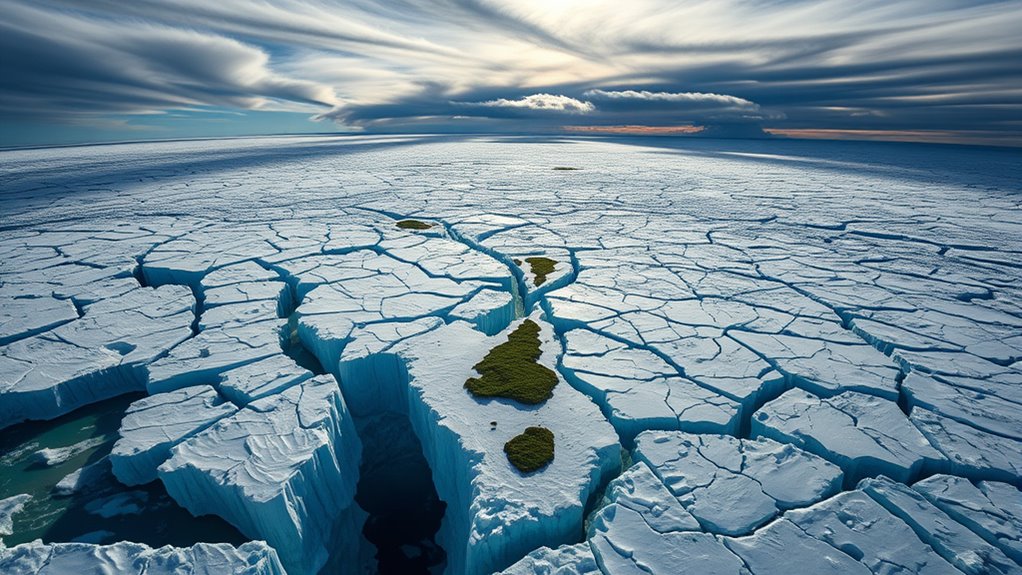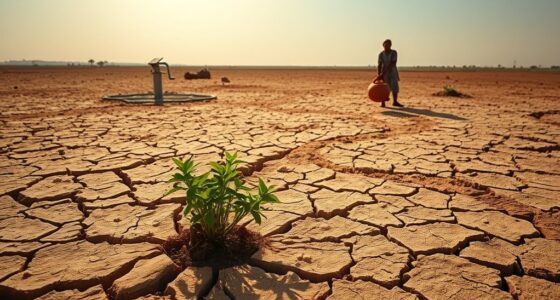You’re nearing critical climate tipping points, where small changes can trigger irreversible and rapid shifts, like ice sheet collapse or huge sea-level rises. Feedback loops, such as melting ice reducing reflectivity, are accelerating these processes. Human activities raising temperatures increase the risk of crossing thresholds that could cause catastrophic environmental impacts. Staying informed about these dangers is essential; if you want to understand how close we truly are, there’s more to uncover.
Key Takeaways
- Several climate tipping points, like ice sheet collapse, may be near or already approached due to rising global temperatures.
- Feedback loops, such as ice melt reducing reflectivity, accelerate climate change and push thresholds closer.
- Scientific signals suggest some thresholds could be crossed within decades if emissions are not significantly reduced.
- Monitoring of critical indicators indicates increasing risk of crossing irreversible climate tipping points.
- Urgent action is essential to prevent surpassing these thresholds and triggering abrupt, catastrophic environmental changes.

Have you ever wondered what happens if the Earth’s climate reaches a critical threshold? It’s a pressing question because our planet’s climate system is complex and interconnected, with certain points where small changes can trigger large, irreversible shifts. These are known as climate tipping points. One key factor that influences how close we are to these tipping points involves feedback loops. Feedback loops are processes where changes in one part of the system amplify or dampen further changes. For example, as global temperatures rise, ice sheets—vast layers of ice covering Greenland and Antarctica—become less stable. When ice sheets lose mass, they reflect less sunlight because ice is highly reflective, and that means more heat is absorbed by the Earth’s surface. This creates a feedback loop: warming causes ice to melt, which leads to more absorption of heat, speeding up the melting process even further. If this feedback loop continues unchecked, it can push the climate toward a tipping point where ice sheet stability is compromised, leading to rapid and substantial sea-level rise. Additionally, scientists are studying how the high sensitivity of these ice sheets to temperature changes could accelerate this process, making the thresholds even more critical to monitor.
Ice sheet stability is particularly concerning because it acts as a sort of planetary thermostat. When ice sheets are stable, they help regulate global temperatures by reflecting sunlight back into space. But once they start melting beyond a certain threshold, the process accelerates, and their structural integrity can collapse. This isn’t a gradual change; it can happen suddenly once a critical point is crossed. Researchers warn that if we reach this threshold, the consequences could be catastrophic, with significant sea-level rise threatening coastal communities worldwide. The stability of these ice sheets depends on multiple factors, including temperature, ocean currents, and atmospheric conditions, all of which are influenced by human activities. As greenhouse gases continue to warm the planet, the risk of crossing these thresholds increases.
Understanding feedback loops and ice sheet stability gives you a clearer picture of how delicate the balance is in Earth’s climate system. Small, incremental changes might seem insignificant now, but they could set off a chain reaction once critical points are crossed. The danger lies in the fact that these tipping points are often nonlinear, meaning the effects don’t happen gradually but rather suddenly once a threshold is surpassed. That’s why scientists emphasize the importance of acting quickly to reduce emissions and slow warming. If we don’t intervene, we could inadvertently push the climate system past these tipping points, leading to irreversible changes that will affect generations to come. The question isn’t just how close we are, but whether we can prevent reaching those dangerous thresholds before it’s too late.
Frequently Asked Questions
What Are the Most Imminent Climate Tipping Points?
You’re wondering about the most imminent climate tipping points. Right now, permafrost melt threatens releasing vast amounts of greenhouse gases, speeding up warming. Coral bleaching is also urgent, as rising sea temperatures devastate ecosystems. These events signal critical thresholds. If they reach a tipping point, they could trigger irreversible changes. Staying aware and reducing emissions can help delay or prevent these disastrous shifts.
How Can We Predict When a Tipping Point Will Occur?
You can predict when a tipping point might occur by relying on climate models that simulate Earth’s systems and identify early warning signs. These models analyze data trends and feedback loops, helping you spot shifts indicating an approaching threshold. By monitoring these signals, scientists can better anticipate potential tipping points, giving you critical time to take action and prevent irreversible changes in the climate system.
What Are the Global Consequences of Crossing a Tipping Point?
When a tipping point is crossed, you face serious global consequences that threaten economic and ecological stability. You might see drastic climate shifts, rising sea levels, and severe weather events disrupting communities worldwide. These changes can damage agriculture, cause economic losses, and threaten biodiversity. Staying aware of these risks encourages proactive efforts to prevent crossing critical thresholds, helping you protect both the planet’s health and your future stability.
Can Climate Tipping Points Be Reversed Once Triggered?
Think of climate tipping points like a glass of water boiling over—you can’t unboil it once it’s done. Once triggered, some changes lead to irreversible damage, making recovery potential limited or impossible. However, not all tipping points are permanent; some can be stabilized or reversed with swift, effective action. Your choices now influence whether we can manage or mend these critical shifts, emphasizing the importance of early intervention.
How Do Local Actions Influence Global Tipping Points?
Your local actions considerably influence global tipping points through local policy and community resilience. When you support sustainable policies and promote resilient communities, you help reduce greenhouse gas emissions and strengthen adaptation efforts. These collective efforts can slow or prevent crossing critical thresholds that lead to irreversible climate changes. By acting locally, you contribute to the global fight against climate change, making a meaningful impact on our planet’s future.
Conclusion
You can’t afford to ignore the warning signs; we’re really skating on thin ice with climate tipping points. Every delay brings us closer to crossing a point of no return, and the stakes couldn’t be higher. It’s a race against time, and the clock’s ticking faster than ever. If we don’t take action now, we might find ourselves in hot water — and that’s one boat we don’t want to be in.








